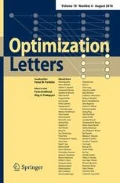Abstract
The generation of covering arrays, which can be regarded as a generalization of orthogonal arrays, is an active research field. In this paper, we propose a memory efficient variant of the well-known AETG greedy algorithm for covering array generation called sliced AETG. The memory usage and runtime of sliced AETG is greatly decreased when compared to that of the original algorithm. We further show asymptotic results regarding the runtime and the number of rows of the generated arrays, which are the same as that of greedy AETG, for fixed alphabet and strength. However, as our experimental evaluation shows, the generated CAs have more rows than those produced by the original version.

Similar content being viewed by others
References
Bryce, R.C., Colbourn, C.J.: A density-based greedy algorithm for higher strength covering arrays. Softw. Test. Verif. Reliab. 19(1), 37–53 (2009)
Cohen, D.M., Dalal, S.R., Fredman, M.L., Patton, G.C.: The AETG system: an approach to testing based on combinatorial design. IEEE Trans. Software Eng. 23(7), 437–444 (1997)
Cohen, M.B., Colbourn, C.J., Ling, A.C.: Constructing strength three covering arrays with augmented annealing. Discret. Math. 308(13), 2709–2722 (2008). Combinatorial Designs: A tribute to Jennifer Seberry on her 60th Birthday
Colbourn, C.J.: Covering array tables for t\(=\)2,3,4,5,6. http://www.public.asu.edu/~ccolbou/src/tabby/catable.html, Accessed 9 Jan 2018
Colbourn, C.J.: Combinatorial aspects of covering arrays. Le Mathematiche LIX(I–II), 125–172 (2004)
Colbourn, C.J.: Covering arrays from cyclotomy. Des. Codes Crypt. 55(2), 201–219 (2010)
Garn, B., Simos, D.E.: Algebraic modelling of covering arrays. In: Kotsireas, I.S., Martínez-Moro, E. (eds.) Applications of Computer Algebra, pp. 149–170. Springer International Publishing, Cham (2017)
Hnich, B., Prestwich, S.D., Selensky, E., Smith, B.M.: Constraint models for the covering test problem. Constraints 11(2), 199–219 (2006)
Kampel, L., Leithner, M., Garn, B., Simos, D.E.: Problems and algorithms for covering arrays via set covers. To appear in Theoretical Computer Science
Kampel, L., Simos, D.E.: A survey on the state of the art of complexity problems for covering arrays. To appear in Theoretical Computer Science
Kitsos, P., Simos, D.E., Torres-Jimenez, J., Voyiatzis, A.G.: Exciting FPGA cryptographic trojans using combinatorial testing. In: 2015 IEEE 26th International Symposium on Software Reliability Engineering (ISSRE), pp. 69–76 (2015)
Kleine, K., Simos, D.E.: Coveringcerts: Combinatorial methods for x.509 certificate testing. In: 2017 IEEE International Conference on Software Testing, Verification and Validation (ICST), pp. 69–79 (2017)
Kuhn, D., Kacker, R., Lei, Y.: Introduction to Combinatorial Testing. Chapman & Hall/CRC Innovations in Software Engineering and Software Development Series. Taylor & Francis (2013)
Maltais, E., Moura, L.: Hardness results for covering arrays avoiding forbidden edges and error-locating arrays. Theoret. Comput. Sci. 412(46), 6517–6530 (2011)
Nayeri, P., Colbourn, C.J., Konjevod, G.: Randomized post-optimization of covering arrays. Eur. J. Comb. 34(1), 91–103 (2013). Combinatorics and Stringology
Nurmela, K.J.: Upper bounds for covering arrays by tabu search. Discret. Appl. Math. 138(1), 143–152 (2004). Optimal Discrete Structures and Algorithms
Seroussi, G., Bshouty, N.H.: Vector sets for exhaustive testing of logic circuits. IEEE Trans. Inf. Theory 34(3), 513–522 (1988)
Smith, R., et al.: Applying combinatorial testing to large-scale data processing at Adobe. In: 2019 IEEE International Conference on Software Testing, Verification and Validation Workshops (ICSTW) (to appear)
Tzanakis, G., Moura, L., Panario, D., Stevens, B.: Constructing new covering arrays from lfsr sequences over finite fields. Discret. Math. 339(3), 1158–1171 (2016)
Acknowledgements
This research was carried out as part of the Austrian COMET K1 program (FFG) and the SecWIT project (FFG Grant 865248, 854188).
Author information
Authors and Affiliations
Corresponding author
Additional information
Publisher's Note
Springer Nature remains neutral with regard to jurisdictional claims in published maps and institutional affiliations.
Rights and permissions
About this article
Cite this article
Kampel, L., Leithner, M. & Simos, D.E. Sliced AETG: a memory-efficient variant of the AETG covering array generation algorithm. Optim Lett 14, 1543–1556 (2020). https://doi.org/10.1007/s11590-019-01459-0
Received:
Accepted:
Published:
Issue Date:
DOI: https://doi.org/10.1007/s11590-019-01459-0



